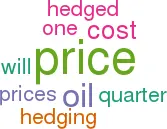Fuelling anxiety
February 2000


With the crude oil price up to around $27/barrel and the wholesale price of jet kerosene touching 80 cents a gallon, there are signs of minor panic in the aviation industry. Don Carty, CEO of American, commented at the end of January: "I'm concerned not just for our industry …I'm concerned for the whole economy".
The recent price rises have reawakened memories of the bad old days when OPEC, at the beginning of the 70s and again in the early 80s, plunged the world into severe recessions after hiking oil prices. However, OPEC is a much weaker and less cohesive organisation than it used to be, and has presided over a halving in the oil price during 1980–99. The recent surge in spot prices is going to be very difficult to sustain because sooner or later (probably sooner) one of the producers will be tempted, or forced by its financial position, to break its quota. Then the oil price will again reflect the fundamental over–supply of the commodity.
That, at least, is Aviation Strategy’s reading of the situation. But if we're wrong, what will be the effect on demand? The OECD, having forecast GDP growth in 2000 based on $17/barrel, has done a sensitivity analysis assuming $27/barrel. The results are: the US economy would fall from 3.1% growth to 2.9%, the EU from 2.8% to 2.6%, and Japan from 1.4% to 1.0%. The main threat would appear to be to Japan’s incipient recovery.
The impact on airline costs is more immediate and tangible, and has caused howls of anguish from the US carriers whose fourth quarter results disappointed. Interestingly, the two most successful airlines in the quarter were Delta (very heavily hedged) and Southwest (despite not having hedged at all).
The response of the US majors, led by Continental, has been to impose a fuel surcharge of $20 or so for most domestic trips. There is a risk here of a consumer backlash — some passenger groups see these surcharges as a sneaky way of pushing up fares permanently. They also wonder about whether they received the true benefits of low jet fuel prices in 1998 and early 99. And questions are being asked about the airlines' hedging policies.
In a low margin business, international in nature, and historically highly cyclical, one would have thought that minimising uncertainty should be a priority for management. With pre–tax profit margins often in the 3–7% range, being able to know for certain the medium term price of one of the major cost items (currently between 14–23% of direct operating costs) should be a major benefit in planning.
There is, of course, a cost associated with hedging. Southwest took the view that the cost of hedging instruments would be greater or the same as the risk–weighted cost of an unexpected price surge. In this case it got it wrong.
Its European counterpart, Ryanair, seems to have got it right. It has in place hedges and options for this year at a similar level to 1999 — around 67cents a gallon — and is already has 30% hedged for the first quarter of 2001. Hopefully, the oil price won’t collapse again.